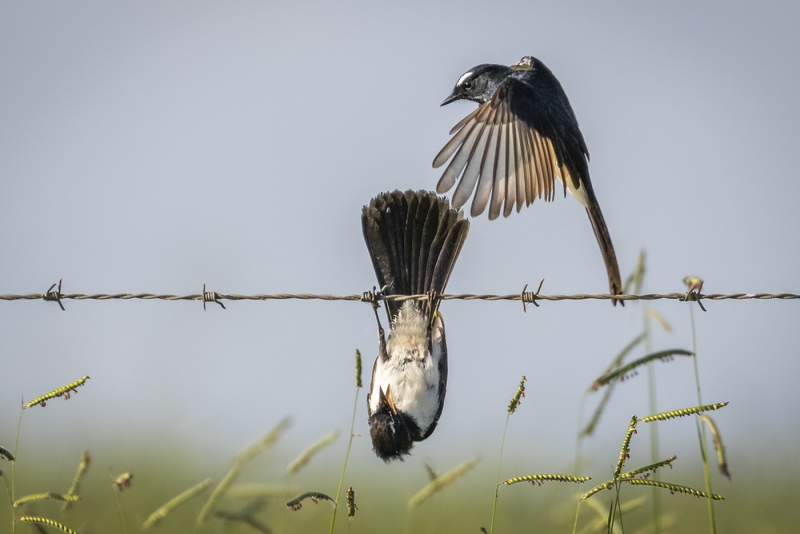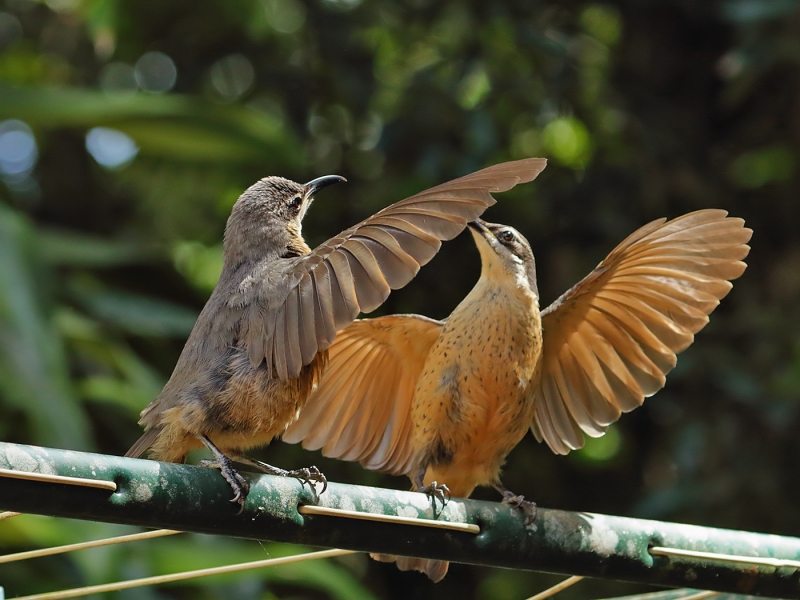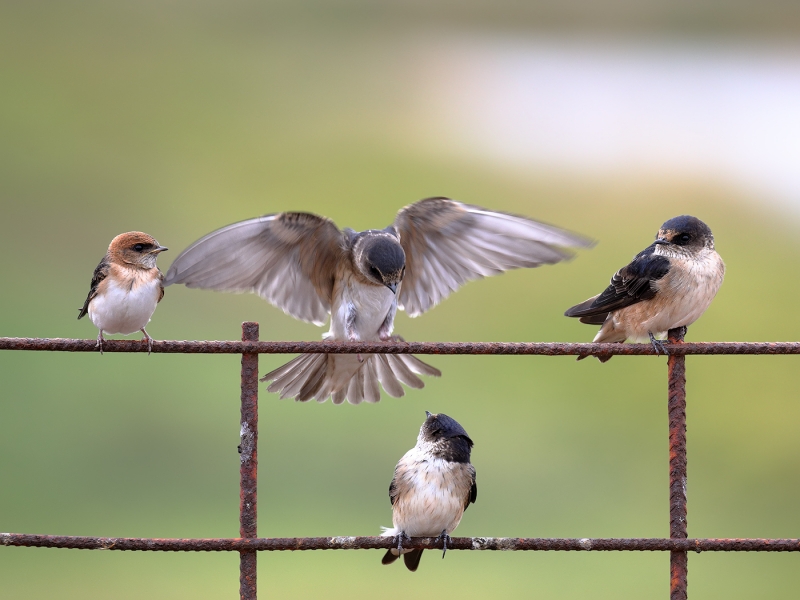The theme for this competition is one of my favourites. Whilst I note the competition co-ordinator’s comment that “wire is one of the least attractive of perches,” I would have to say “Not always!”. Wire can possess some wonderful tones and textures that add a unique and artful perspective to an image. Whilst I lament the compartmentalisation of the Australian landscape as a result of our European fencing heritage and the damage fencing inflicts on animals, there is a subtle romantic quality that rusty fencing displays in early morning and late afternoon light.
During the course of this competition I regularly overheard comments to the effect that some photographers would never capture an image of a bird on a fence or any object that can be assigned to the ‘hand of man.’ There is very little difference of course between a bird on a plant-based stick and a bird on a metal stick, the technical quality and wow factor of an image is a direct reflection of the art and craft of the photographer. I’m delighted to say that a substantial number of photographers entered this competition and that the overall quality of entries was extremely high, which made selecting the list of finalists most difficult. Unfortunately, this translates to a large number of quality images that are not mentioned in this article. Suffice it to say that with so many quality entries, that in addition to the specified theme for this competition I was looking for an additional dimension in each image; a behavioural or conservation context or an image that arouses one’s emotions, rather than the classic portrait.
After considerable contemplation over several days I succumbed to indecision and awarded two winning entries, each in their own right a worthy winner.
Winner: Crested Pigeon, by Cherilyn Corker (Image ID 35021)
Capturing a super sharp image of this displaying crested pigeon, balancing on the upper strand of a barbed-wire fence, is no easy task. The tones and texture in the wire blend with the wonderful bokeh of the background. The texture of the wire in itself is a dramatic reflection of the effects of salt spray over a long period of time and is markedly different to that of corrosion in a drier environment. One of the enduring features in the image is the orientation of the head, in which the eyes convey a pseudo-oriental appearance that ensures the viewer will take a second look at the image. The upright tail during this display adds another unique aspect to this image and the square nature of the crop is a good choice. If this bird was a male and displaying to a female, I wonder if she noticed the superb colours in the newly emerging tail feathers, emphasised by the loss of several upper tail coverts – did you notice this?
Winner: Willie Wagtail, by Linda Joseph (Image ID 35194)
Of equal merit is this superbly captured behavioural interaction between two birds; captured perhaps by being patient and waiting for the birds to interact -- perhaps being prepared and in the right place at the right time. Either way this image is a worthy winner. The image is sharp and the position of the two birds adds drama to this composition as well as a ‘story-line’ in the mind of the viewer. The background complements the image in two respects; the first is that the tonal quality does not compete with the main subjects, and second, the paspalum like the barbed-wire has been ‘introduced’ into the Australian environment. The green and grey-green tones of the vegetation blend seamlessly with the rest of the background bokeh. My only suggestion for this image is that I might have been inclined to crop closer on both the left- and right-hand sides rather than adhering to the original format.
Commended: Brown Goshawk & Emu, by Brett Roberts (Image ID 35208)
This is a powerful image and only just missed the top spot. It is a tragic image, with the sole responsibility for the welfare of the Emu resting with mankind; one can only imagine the disproportionate grief elicited by a similar image in which the feet of the emu are replaced with the boots of an equally unfortunate farmer.
In terms of composition, the central subjects are perfectly placed, the three strands of wire that intersect and then separate again on the opposite side add a level of symmetry and dimension to the image. The overall brown tones of the image, which essentially make this a monochrome image, convey a degree of sadness and despair. Eye contact with the Goshawk expresses a mutual degree of shock.
Why didn’t I pick this image as a winner? There is a minor artefact at the top of the frame – a dark black blob, which draws my eyes away from the central horror. If this image was not submitted in a competition, I would use PS Content Aware or the PS Clone tool to replace this black area with the tones and texture of the adjacent background. The image would also be slightly more dramatic if captured with a greater depth of field, bringing the emu’s claws into focus. I might also be tempted to apply a little overall contrast and perhaps a little mid-tone contrast. These are minor criticisms in an image that arouses overwhelming emotion.
Commended: Victoria’s Riflebird, by Gary King (Image ID 35248)
There are qualities in this image which deserve acknowledging. Once again, patience and being in the right place at the right time has paid-off with an excellent behavioural image. The wire is also different to that of the other images in that it is plastic coated and stretched around the metal frame of a clothes line. The frame itself offers some variety with what appears to be lichen covering the green tubing. The birds are well positioned, and the eye contact between the two birds highlights the intensity of the ‘dance’. The fact that the right-hand bird’s beak is partially obscured behind the wing of the second bird does not lessen the quality of this composition in my view. The background is somewhat busy but well controlled in terms of brightness and distracting elements, although there a few brighter spots that could be removed or diminished by using the “Dodge’ tool in PS. The photographer might consider applying a light vignetting to highlight the central subjects.
Commended: Fairy Martin, Tree Martin, by Con Duyvestyn (Image ID 34745)
This is a delightful composition and again, one in which invokes a ‘story-line’ in the mind of the viewer. The action in this image is well positioned centrally to focus the attention of the viewer on the bird alighting on the wire mesh. The focal point is enhanced by the fact that the other three birds are making eye contact with the landing bird. There is a level of subtle variety in the image, perhaps only obvious to ornithologists but present nonetheless – yes, it is the fairy martin on the left of the image. The image is sharp and the blurred wings simulate movement. The orange and brown tones of the rusted wire frame provide a harmony with the similar tones in the plumage of the birds. Some viewers may not like the bird excrement on the wire but hey – this is nature in the raw! Overall the background bokeh comprises pleasing tonal greens, except for the large off-white area along the top edge. As with the goshawk/emu image, if this image was not submitted in a competition, I would use PS Content Aware or the PS Clone tool to replace this black area with the tones and texture of the adjacent background.
Commended: Striated Fieldwren, by Barry Deacon (Image ID 35114)
My second introductory paragraph clearly states that I am looking for more than just the beautiful classic portrait for this competition and so I hear you say that this photo fits clearly in the ‘classic’ category. I admit that it does and yet for me there is more to this image than just a bird portrait. The background is exquisite; those subtle grey-green tones of the slightly out-of-focus leaves add a level of sophistication to the image. I also like the subtlety that the in-focus stem brings to the lower right-hand corner of the image, as it bends beneath the wire. The thick braided wire adds a degree of novelty and elegance to the image and the wire’s uniform grey tone blends perfectly with the grey-greens of the background. Even the black streaks on the breast and wing coverts of the bird mimic the form of the braided wire. I really like this image even though it is more in the portrait style, and I think one of the main reasons why I kept coming back to view this image is the overall colour palette and the fact that unlike the majority of portraits with beautifully smooth bokehs, this image has an equally refined background emphasising ‘habitat’ – well seen and beautifully captured.
Special Mention:
Rarely do I include special mentions, and the reason for this is that there are always so many great images and the temptation is to compile a long list of images that have a least one element worthy of comment.
However, in this competition there was one photo which stood out from the rest and must receive praise. The photo to which I refer is the Welcome Swallow, by Warren Bennett (Image ID 35288).
A superbly crafted capture of a Welcome Swallow stretching its wings in a vertical direction and captured uniquely from behind the bird. For this type of image there is the desire for perfect balance and symmetry, which is extremely difficult to achieve in a live, moving animal. In this instance the bird is slightly rotated to face the left as well as a slight tilt to the left. One advantage of this orientation, however, is that there is just the slightest reveal of the bird’s crown, which provides immediate context for this image. This is one of those images which if presented as a colour print, would definitely hold the attention of every passing viewer. In addition to the creativity in this image, the bokeh is excellent, and the white coated wire passing horizontally through the centre of the frame is part of the image’s overall symmetry.
Finally, I congratulate all those who entered this competition. There are so many images which deserve a commendation. My recommendation is to review your entries against those in the Advanced competition; a number of you should move to the Advanced level at the start of 2020.






